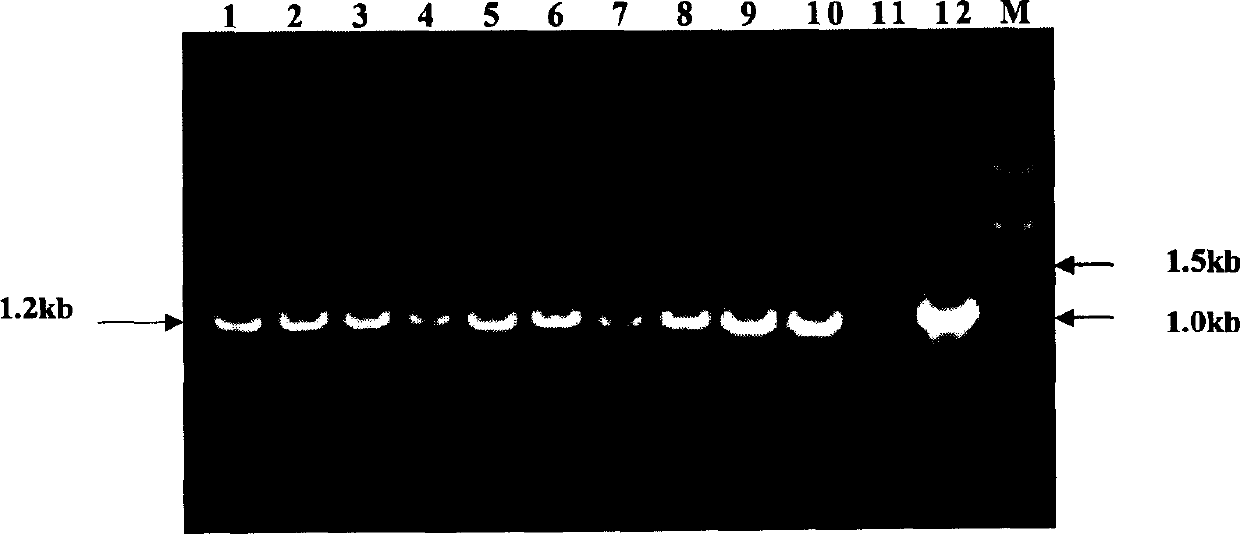One coding gene of rotavirus VP6 protein and its application
A technology of rotavirus and coding gene, which is applied to the coding gene of rotavirus VP6 protein and its application field, which can solve the problems of unsuitable for commercial production of oral vaccine, reduced content of antigenic protein, no effective treatment and prevention means for diarrhea, etc. , to achieve the effects of low cost, easy preparation, and reduced production cost
- Summary
- Abstract
- Description
- Claims
- Application Information
AI Technical Summary
Problems solved by technology
Method used
Image
Examples
Embodiment 1
[0060] Example 1. Human group A rotavirus VP6 gene-sVP6 gene and sVP6-SEKDEL gene synthesized using dicotyledonous plant preferred codons
[0061] Using DNAMAN software to analyze the coding region sequence of the human group A rotavirus VP6 gene (GenBank AF260931), analyze its A+T percentage content, restriction endonuclease sites, translated amino acid sequence, and codon usage preference . Compare the difference between the sequence of the VP6 gene coding region and the codon preference of dicotyledonous plants, and without changing a single amino acid sequence, modify the sequence of the VP6 coding region to make its codon preference close to that of dicotyledonous plants, and try to avoid using Rare codons NCG and NTA.
[0062] In addition, to ensure the production of mature translatable mRNA, the following sequence was modified
[0063] 1) Transform the six polyadenylic acid (Poly(A)) signal sequences in the sequence of the coding region of the VP6 gene, so as to preve...
Embodiment 2
[0067] Embodiment 2, preparation rotavirus oral vaccine
[0068] 1. Construction of plant transformation vector expressing sVP6 gene
[0069] Utilize restriction endonuclease NcoI and SacI to digest pUsVP6 plasmid, reclaim the sVP6-SEKDEL gene fragment that size is 1.2kb, and insert it into the NcoI / SacI position of vector pRTL2 (J.Virol., 1990,64:1590-1597) point, the recombinant plasmid pRsVP6 containing the sVP6-SEKDEL gene was obtained. Then use HindIII and Sac I double enzymes to cut pRsVP6, and reclaim the cauliflower mosaic virus (CaMV) 35S promoter+tobacco etch virus (TEV) 5' untranslated region (5'-UTR) containing "double enhancer" with a size of 2.4kb ) + Kozak sequence + sVP6-SEKDEL” fragment, which was ligated with the pBI121 plasmid that had been digested with the same double restriction enzymes, to obtain the binary expression vector pBsVP6. The vector construction diagram is shown in Figure 2A.
[0070]The T-DNA region of pBsVP6 plasmid contains two gene expre...
Embodiment 3
[0089] Example 3. Oral immunization of mother mice with transgenic alfalfa expressing rotavirus VP6 protein can protect offspring mice
[0090] In this study, CpG ODN whose backbone was modified by phosphorothioation was used as an immune adjuvant. Its sequence is TCCATGACGTT CCTGACGTT (CpG ODN 1826), which was synthesized by Shanghai Sangon Bioengineering Company and used at a dose of 10 μg / time. After asexual reproduction of transgenic alfalfa with high expression of sVP6 protein, a large amount of material can be obtained for immunization of mice within three months. After 30% and 60% (NH 4 ) 2 SO 4 The transgenic alfalfa stem total soluble protein (TSP) obtained by fractional precipitation was redissolved in 0.1M PBS, and TSP was dialyzed with normal saline for 24 hours and then used for oral immunization of mice.
[0091] Thirty BALB / c female mice aged 6-8 weeks were divided into 3 groups, 10 in each group, and were immunized by intragastric administration once a week ...
PUM
| Property | Measurement | Unit |
|---|---|---|
| antibody titer | aaaaa | aaaaa |
Abstract
Description
Claims
Application Information
 Login to View More
Login to View More - R&D
- Intellectual Property
- Life Sciences
- Materials
- Tech Scout
- Unparalleled Data Quality
- Higher Quality Content
- 60% Fewer Hallucinations
Browse by: Latest US Patents, China's latest patents, Technical Efficacy Thesaurus, Application Domain, Technology Topic, Popular Technical Reports.
© 2025 PatSnap. All rights reserved.Legal|Privacy policy|Modern Slavery Act Transparency Statement|Sitemap|About US| Contact US: help@patsnap.com



